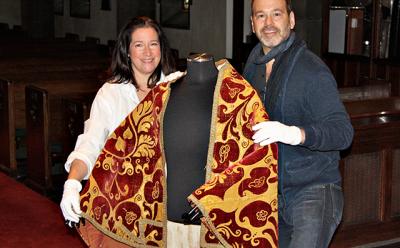Sacred Threads: An Extraordinary Collection

“Sacred Threads,” an exhibition of ecclesiastical vestments and textiles from the 14th to the 18th centuries from the collection of Jill Lasersohn, will open to the public on Sunday at St. Luke’s Episcopal Church in East Hampton and remain on view through May 30. A reception benefiting a number of local charities will be held Saturday from 6 to 8 p.m.
The exhibition marks the first time works from Ms. Lasersohn’s holdings, one of the largest private collections in the country, will be on public view. It will include early Renaissance velvets and silks, rich with gold threads; a set of bishop’s gloves, and a set of gold buttons used to elect a doge in 14th-century Venice, with an accompanying image of a painting by Giovanni Bellini.
Ms. Lasersohn, who lives in East Hampton, explained that ecclesiastical garments were protected during wars, crusades, and the Reformation. The priest or minister or deacon would wear them only on important holidays. Nuns and monks repaired damaged garments. “When towns would be pillaged, these would be hidden, sometimes in the oddest places,” she said.
Clothing from the Renaissance is extremely rare. “Even the wealthiest people, like the Medicis, had only five or six gowns. Textiles were so expensive that, when you look at paintings from the period, you’ll see that sleeves are pinned or laced on. They could be removed.” A single garment might have taken six months to weave, and the dyes, which were imported, were sometimes more expensive than the articles themselves. “Renaissance bankers made their money from the dyes and the alum that would secure the dyes to the fabric.”
Ms. Lasersohn began collecting 25 years ago after her husband’s career forced them to relocate from Manhattan, where she was working for Town & Country magazine, to Silicon Valley. “My husband was born and raised on the Upper West Side, so he couldn’t wait to buy land, and he bought a lot of it. While he was at work, I had nothing to do, no neighbors, no family. I was bored to tears, and he knew when he would get home I would be pretty clingy.”
Her husband, Jack Lasersohn, a health-care venture capitalist, asked her what her dream job would be. “I had been fascinated by textiles and fashion since the second grade, and I studied textiles in college, so I said I wanted to start a textile collection. Soon after that, he had business in France, so while he was working, I went to the flea market in Paris.”
Over the years, her sources have included dealers such as Cora Ginsburg, a foremost authority in the field; auctions, and flea markets, with an occasional find on eBay. “A collector never stops looking for the piece she doesn’t have,” she said. “I don’t collect American, because there isn’t much of it from before the 19th century. I’m fascinated with the 18th century and earlier. I like Turkish textiles, butmost of what I have is Italian, French, English, and Spanish. I’m hungry now for the 1300s, but I still love the 18th century.”
Her collection includes needlepoint, needlework, embroidery, brocades, velvets, silks, and damasks. She also has a large group of toile de Jouy and printed cottons, as well as tapestries, lace, and buttons. On her travels, “visiting museums is all I do. I’m a museum rat. I love books on textiles, and five years ago I became crazy buying art books, because I would go through them and I’d find pieces of mine in paintings.”
Because antique textiles are so fragile, museums rarely put them on public view. Most are in storage, and an appointment is necessary to see them. Similarly, Ms. Lasersohn’s collection requires handling with white gloves, storage in boxes with acid-free tissue paper, and other protective measures. “Even though, because they are going to be handled, there is going to be some wear and tear in this exhibition, I’ve been having so much fun getting to see them.”
The Internet has made collecting easier than it was 25 years ago, “but it has also increased my competition. Years ago at auctions, you’d get your paddle, everybody knew who you were, you knew the dealers, the auctioneer, and you’d raise your paddle. Now it’s not only telephone calls and pre-bidders, it’s also the computer. I’ve got somebody in Tokyo who collects Renaissance velvets bidding against me.”
The St. Luke’s exhibition came about when, several years ago, Mary Busch, who, like Ms. Lasersohn, is on the board of the East Hampton Historical Society, wanted to do a fund-raiser for the church’s outreach programs. “I mentioned my collection, thinking of a small show, but Mary had a different idea. We’ve put together a beautiful catalog, we’ve done a tristate outreach, and I’m interested in getting the fashion world involved, too.”
Charles Keller and Glenn Purcell, fashion designers who are collectors of objects made by Dominy family craftsmen, have overseen the installation. “Everybody is volunteering their time,” Ms. Lasersohn said, “and they’re putting in a lot of hours. And it’s all for outreach. I don’t know how many communities would do this.”
There is no charge to visit the exhibition, which will be open Thursdays, Fridays, Saturdays, and on Memorial Day from 10 a.m. to 2 p.m., and Sundays from 1 to 3. However, a $20 donation will be appreciated. All donations will help fund Meals on Wheels, the Retreat, East End Hospice, Maureen’s Haven, and St. Luke’s Brown Bag Lunch and Laundry Love. Tickets for the benefit party are $150.
Private group tours with Ms. Lasersohn will be available on Wednesdays throughout May. Arrangements can be made by emailing jenniferborg@me. com.
Correction
An earlier version of this article incorrectly stated that Ms. Lasersohn had worked for Glamour magazine. She in fact worked for Town & Country.
